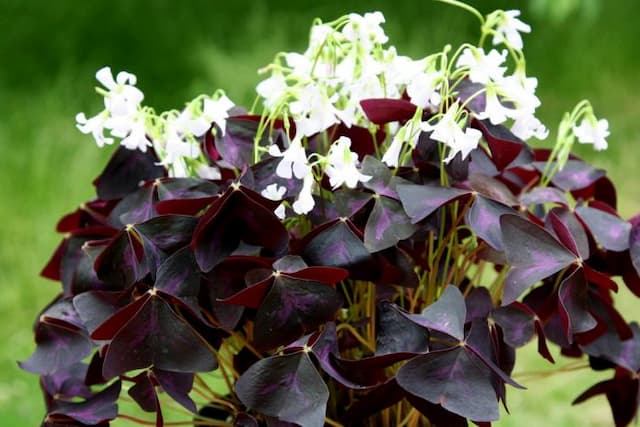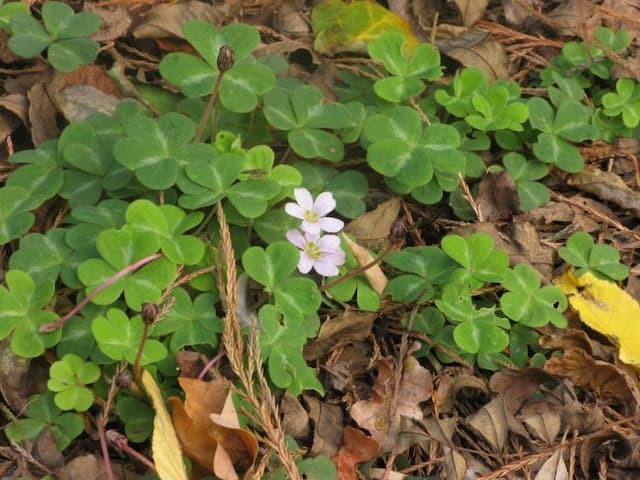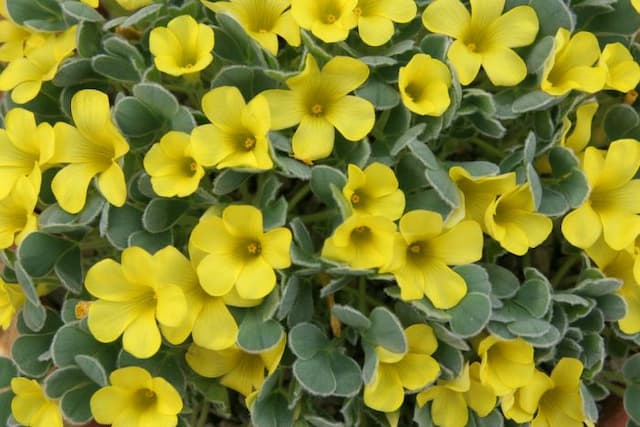False Shamrock Oxalis 'Gwen McBride'

ABOUT
Oxalis 'Gwen McBride' is a charming ornamental plant known for its distinct foliage and flower characteristics. The plant sports lush green leaves that are uniquely shaped like a shamrock or a heart, adding an endearing and whimsical quality to its appearance. Each leaf typically consists of three leaflets that are joined together at the base, forming a clover-like silhouette that is often associated with good luck. The leaves have a delicate, yet robust structure, supported by thin, slightly arching stems that give the plant a gentle and airy appearance. During certain times of the day or in response to environmental changes, the plant has the ability to fold its leaves down at the petiole, which is a fascinating display of its natural movement. One of the most striking features of Oxalis 'Gwen McBride' are its blooms. The flowers are dainty and cup-shaped, with petals that radiate outwards creating a star-like formation. They are usually a soft hue, which contrasts beautifully against the green backdrop of the foliage. The blooms are held aloft on slender stalks that rise modestly above the foliage, giving them a floating impression as if they are hovering within a green sea. Oxalis 'Gwen McBride' exudes a gentle and soft charm thanks to its petite and endearing flowers, along with its distinctive shamrock-shaped leaves. It makes a lovely addition to any garden or indoor collection and is favored by those who enjoy plants with a playful yet elegant nature.
About this plant
 Names
NamesFamily
Oxalidaceae.
Synonyms
False Shamrock, Sorrel, Wood Sorrel, Love Plant, Iron Cross.
Common names
Oxalis 'Gwen McBride'.
 Toxicity
ToxicityTo humans
Shamrock is considered mildly toxic to humans if ingested due to its oxalic acid content. Consuming large quantities can lead to symptoms such as nausea, vomiting, diarrhea, and abdominal pain. In rare cases and with significant ingestion, more severe symptoms like kidney stones and even kidney failure can occur due to the oxalate crystals interfering with kidney function.
To pets
Shamrock is also toxic to pets, including cats and dogs. It contains soluble oxalates, which can lead to symptoms like drooling, vomiting, diarrhea, and decreased appetite. In severe cases, ingestion can result in tremors, seizures, or kidney failure. Immediate veterinary care is advised if a pet consumes this plant.
 Characteristics
CharacteristicsLife cycle
Perennials
Foliage type
Evergreen
Color of leaves
Green
Flower color
White
Height
0 feet 6 inches (15 cm)
Spread
0 feet 6 inches (15 cm)
Plant type
Herb
Hardiness zones
7
Native area
South America
Benefits
 General Benefits
General Benefits- Ornamental Value: Adds a charming aesthetic with its delicate white flowers and striking purple foliage.
- Drought Tolerance: Can survive periods of dryness once established, making it suitable for xeriscaping.
- Low Maintenance: Requires minimal care and can thrive with basic gardening practices.
- Shade Tolerance: Can grow in partially shaded areas where other plants may struggle.
- Rapid Growth: Quick to establish and spread, filling in garden spaces efficiently.
- Attracts Pollinators: Flowers may attract beneficial insects like bees and butterflies to the garden.
- Edibility: Leaves can be used in small quantities to add a lemony flavor to salads and dishes, though they contain oxalic acid so should be consumed in moderation.
- Groundcover: Effective at covering bare spots in the garden, reducing weed growth by outcompeting them for resources.
 Medical Properties
Medical PropertiesThis plant is not used for medical purposes.
 Air-purifying Qualities
Air-purifying QualitiesThis plant is not specifically known for air purifying qualities.
 Other Uses
Other Uses- Oxalis 'Gwen McBride' can be used as a natural pH indicator. Its purple leaves may change shades when in contact with substances of differing acidity.
- The plant is sometimes used in educational settings for plant biology studies because of its distinct leaf movements in response to light.
- The vibrant colors of the leaves can serve as an inspiration for artists and designers seeking natural color palettes.
- Due to its unique appearance, Oxalis 'Gwen McBride' might be used in photography as an intriguing and attractive subject for botanical themed art.
- The plant could be used in terrariums to create a miniature landscape, taking advantage of its small size and shade tolerance.
- It can be placed in containers with other acid-soil-loving plants creating a symbiotic garden arrangement that highlights differing plant forms and textures.
- Oxalis 'Gwen McBride' is sometimes used in butterfly gardens as it can attract certain species of butterflies and bees when in flower.
- The plant can be used in culinary presentations as an aesthetic garnish because of its decorative foliage, although it should not be consumed.
- It may be employed in stress-relief and mindfulness practices; the act of caring for and observing the plant's growth can promote relaxation.
- Due to its compact size, Oxalis 'Gwen McBride' can be used in creative crafting, such as living wreaths or table centerpieces for events.
Interesting Facts
 Feng Shui
Feng ShuiThe Shamrock is not used in Feng Shui practice.
 Zodiac Sign Compitability
Zodiac Sign CompitabilityThe Shamrock is not used in astrology practice.
 Plant Symbolism
Plant Symbolism- Luck: Often associated with good fortune, particularly the Oxalis triangularis species, which is commonly known as false shamrock or purple shamrock and resembles the lucky four-leaf clover.
- Resilience: Oxalis plants are known for their ability to bounce back and thrive even after experiencing challenging conditions, symbolizing the resilience and perseverance in adversity.
- Balance: The symmetry of the Oxalis leaves, often in groups of three, is suggestive of balance and harmony in life.
- Transformation: Many Oxalis species display nyctinasty, where the leaves open and close in response to light, symbolizing change and adaptability.
 Water
WaterFalse Shamrock or Wood Sorrel should be watered when the top inch of the soil feels dry to the touch. Generally, this equates to watering approximately once a week, but the frequency may increase if it's in a warmer or drier environment. Provide about 8-16 ounces of water each time, making sure to wet the soil thoroughly until excess water drains through the pot's bottom. During the dormancy period in winter, reduce watering to every two to three weeks or when the soil remains mostly dry, as the plant requires less moisture during this time.
 Light
LightFalse Shamrock flourishes in bright, indirect sunlight. A spot near an east or north-facing window can provide ample light without the harsh rays of direct sunlight that could potentially scorch the leaves. Avoid placing it in full, direct sun especially during the peak hours of the day; a light shade may benefit the plant during these times.
 Temperature
TemperatureFalse Shamrock prefers temperatures between 60 and 75 degrees Fahrenheit but can survive in temperatures as low as 50 degrees and as high as 80 degrees Fahrenheit. However, if the temperature drops below 50 degrees, the plant may enter a state of dormancy. It's best kept away from drafts and extreme temperature fluctuations to maintain a consistent growing environment.
 Pruning
PruningPruning the False Shamrock is beneficial for maintaining its shape and encouraging fuller growth. Trim back leggy stems or remove dead leaves whenever necessary throughout the growing season, usually in the spring and summer. It's typically not necessary to prune a lot; doing so too often can hinder growth.
 Cleaning
CleaningAs needed
 Soil
SoilOxalis 'Gwen McBride', commonly known as Sorrel or Shamrock, thrives in a well-draining soil mix composed of peat, perlite, and pine bark with an added portion of sand to enhance drainage. The best soil pH for Sorrel is slightly acidic to neutral, ranging from 6.0 to 7.0.
 Repotting
RepottingSorrel should be repotted every two to three years to refresh the soil and to accommodate growth. This is typically done in spring before the new growth starts.
 Humidity & Misting
Humidity & MistingSorrel prefers moderate to high humidity levels, ideally around 50% or higher, to maintain its lush foliage and promote healthy growth.
 Suitable locations
Suitable locationsIndoor
Ensure bright, filtered light and keep moist.
Outdoor
Place in partial shade with well-draining soil.
Hardiness zone
6-11 USDA
 Life cycle
Life cycleOxalis 'Gwen McBride', commonly known as the shamrock plant, starts its life cycle with seed germination, requiring a moist environment and proper light to sprout. As a bulbous plant, it grows from small bulbs that send up the trifoliate leaves and stems. The leaves develop rapidly, and the plant soon reaches the vegetative growth phase, where it forms its characteristically heart-shaped green and silver-patterned foliage. Following the vegetative stage, it enters a blooming phase under favorable conditions, producing delicate white or pink flowers that can self-pollinate or be pollinated by insects. Once pollinated, it sets seed that matures and is dispersed to start a new generation. The plant may experience dormancy, particularly when winter approaches, retracting into its bulbs to survive unfavorable conditions until the cycle can begin again with the return of warm weather.
 Propogation
PropogationPropogation time
Spring-Early Summer
Oxalis 'Gwen McBride', commonly known as false shamrock or wood sorrel, can be propagated predominantly through division, typically in the spring or fall when temperatures are mild. Division involves separating the plant's bulb-like structures, often referred to as rhizomes or tubers, ensuring that each division has at least one growth point. To propagate, gently lift the parent plant from the soil and brush off excess dirt, carefully detaching clumps of tubers by hand or with a clean knife. Once separated, replant these divisions immediately into moist soil at approximately the same depth they were originally growing, which is typically around an inch (2.54 cm) below the soil surface. Water the new plantings lightly to settle the soil around them and keep them in a warm, well-lit environment, avoiding direct intense sunlight until they show signs of growth.



